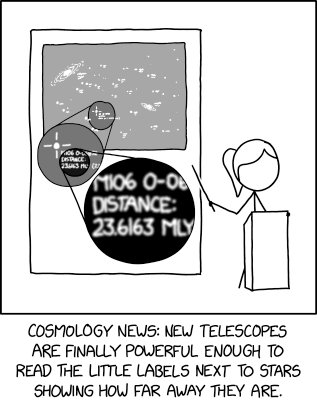Cosmic Distance Calibration

This is the biggest breakthrough since astronomers noticed that the little crosshairs around red giant stars starting to burn helium are all the same size.

This is the biggest breakthrough since astronomers noticed that the little crosshairs around red giant stars starting to burn helium are all the same size.
Astronomical photographs sometimes have various labels added for the objects in them, such as names, distances, stellar classifications, etc. The comic interprets the labels next to stars in the image as actual objects in space, which is absurd because, among other reasons, they are in English, they could be observed from other distances and angles where they wouldn't be correct, they wouldn't stay in place by the star, and probably a hundred other reasons. If these labels were to become astrophysical objects in reality, made of any kind of matter we're aware of, it would quickly result in major changes to the universe. As each of these labels would need to be clearly visible from an observatory, they would require monstrous size — maybe even big enough to collapse into black holes when applied to particularly distant stars. They would also create a sudden lack of need for themselves, as the stars would be gravitationally attracted to their respective labels and promptly destroyed.
The label in this image appears to be pointing to a star in the spiral galaxy M106 (also known as "Messier 106" and "NGC 4258"), located between 22 and 25 million light-years (MLY) away from Earth and compatible with the 23.6163 MLY shown in the comic.
The title text extends the main joke by suggesting that the "crosshairs" around red giant stars, put into an image by an astronomer to indicate those stars starting to burn helium, are actual objects in space which are of a standardized size when seen from Earth. One such set of crosshairs can be seen in the comic. Stars at this stage of stellar evolution are of particular astronomical interest because they all have the same absolute brightness, allowing their distance to be determined because the observed luminosity is a simple inverse-distance-squared falloff from a known original value. This is referred to as the "tip of the red-giant branch" (TRGB) distance calculation method, referring to the red-giant region of the Hertzsprung–Russell diagram. This allows estimation of distances not only to the stars themselves, but also to distant galaxies that contain them. In the weeks before this comic appeared, findings based on measurements of star and galaxy distances reinforced a longstanding quandary in cosmology known as the Hubble tension.